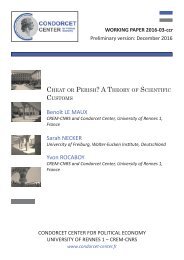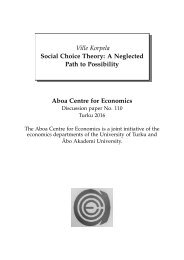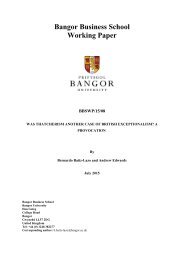MEMORANDUM
n?u=RePEc:hhs:osloec:2016_018&r=hpe
n?u=RePEc:hhs:osloec:2016_018&r=hpe
Create successful ePaper yourself
Turn your PDF publications into a flip-book with our unique Google optimized e-Paper software.
Now we have the curious situation that if the material at hand fulfills our<br />
assumptions it is impossible to determine these constants a ij that express the nature<br />
of our assumptions, because in this case we would only have a single observation,<br />
namely, the one corresponding to the solution of the system. But if our assumptions<br />
are not fulfilled, then it may be possible to determine what they constants a ij .<br />
Suppose, for example, that the functions F 1 , F 2 ... contained also another set of<br />
variables, ξ 1 ,ξ 2 ...ξ m , m being at least equal to 1. Our set of structural relations then<br />
will take the form<br />
F 1 (x 1 ,x 2 ,...x n , a 11 , a 12 ..., ξ 1 ,...ξ m ) = 0<br />
F 2 (x 1 ,x 2 ,...x n , a 21 , a 22 ..., ξ 1 ,...ξ m ) = 0<br />
. . . . . . . . . . . . . . . . . . . . .<br />
F n (x 1 ,x 2 ,...x n , a n1 , a n2 ..., ξ 1 ,...ξ m ) = 0<br />
Furthermore, let Ω(ξ 1 ,ξ 2 ...ξ m ) be the frequency distribution of the set<br />
(ξ 1 ,ξ 2 ...ξ m ). Then to this frequency distribution of the set ξ there corresponds a<br />
certain frequency distribution Π(x 1 ,...x n ) known from observation. We see that now<br />
we really do get variations in the set (x 1 ,...x n ).<br />
Now it is quite clear that the relation between the distribution Ω and the<br />
distribution Π depends in a characteristic way on the magnitude of the parameters<br />
a ij . Further, by expressing the fact that the x distribution deduced from the ξ<br />
distribution (that is, from the function Ω) is identical with the actually observed x<br />
distribution (that is, with the function Π), we obtain a system of equations in a ij<br />
which will furnish a solution of the set a ij provided the equations in question are<br />
theoretically and practically solvable.<br />
Thus in point of principle, the constant a ij may be determined if we know Ω.<br />
Actually, of course, we do not know Ω but we may make some more or less<br />
plausible assumptions about it. To every such assumption corresponds a set a ij . In<br />
an actual case, the formulae connecting Π and Ω would give an exact expression for<br />
the effect of a change in the assumptions regarding Ω. Such a formula, it seems to<br />
me will be of some value as a check on the perfectly gratuitous assumptions which<br />
are sometimes made in this field.” (Frisch to Schumpeter, 13 December 1930).<br />
Frisch’s letter thus foreshadowed an ingenious kind of probability approach to<br />
Leontief’s problem. Leontief never got to see the letter from Frisch. When Frisch in 1933<br />
published his Pitfalls essay with a sharp criticism of Leontief’s work it came without this<br />
line of thought.<br />
* * *<br />
After advising Leontief with the applications Mordecai Ezekiel left for Berlin where<br />
he took lessons to improve his German language. He visited Leontief’s parents several<br />
60





